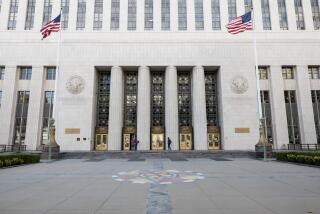Courthouse Restoration Funds OKd : Refurbishment: $5.1-million project will convert historic former federal courthouse to a bankruptcy court.
- Share via
A much-delayed project to refurbish San Diego’s historic former federal courthouse won final funding approval Thursday in Congress, and construction should resume again this summer to convert the elegant building to a bankruptcy court, officials said.
A congressional panel approved the release of $5.1 million Thursday, the last step in a complex bureaucratic funding maze, U.S. Rep. Bill Lowery (R-San Diego) said.
Construction at the old courthouse, which ground to a halt 15 months ago, should resume within weeks, with completion scheduled for January, 1994, judges said.
“We couldn’t be more pleased,” said San Diego U.S. District Judge John S. Rhoades, who since 1986 has helped promote and raise money for the renovation.
The 79-year-old courthouse, on F Street and formally called the Jacob Weinberger Federal Building, has been an essential part of space planning at the existing courthouse, a block away on Front Street.
The existing modern courthouse, a reddish stone structure that opened in 1976, has been crowded for several years, and construction there--for more courtrooms and expanded office space--has been virtually continuous. Crews are now building courtrooms on what used to be a lawn in front of the building.
The San Diego federal court has the highest per-judge criminal caseload in the nation, according to federal statistics. Projections are for the court to add four judges to the bench by 1995.
Under a longstanding plan, those new judges have been slotted to take over courtrooms occupied by the bankruptcy court. In exchange, bankruptcy judges will move to five refurbished courtrooms at the former courthouse, a tile-roofed building widely praised for its blend of classic revival and Spanish colonial architecture.
Originally, renovation of the Weinberger building was billed at $5.4 million. But, after $4 million had been spent, crews discovered lead paint and asbestos, and, in March, 1991, work ground to a halt. Last August, the General Services Administration terminated the project.
Three months ago, Rhoades called Lowery for help. Lowery, who serves on the House Appropriations Committee, said he made the project a personal priority, and secured new funding approval from GSA, then from the Office of Management and Budget.
The Subcommittee on Public Buildings and Grounds of the House Public Works Committee, which held a hearing on the building last week, gave its approval Thursday, Lowery said.
More to Read
Sign up for Essential California
The most important California stories and recommendations in your inbox every morning.
You may occasionally receive promotional content from the Los Angeles Times.










